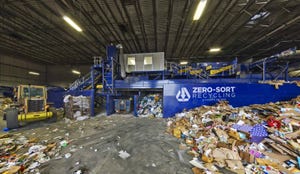Circular File: Turning the Pile
May 13, 2013
I enjoy composting. I enjoy its physicality as I turn my compost pile. In the fall, when my leaves, grass, coffee grounds, and banana and orange peels have turned into compost, I eagerly spread it on my garden. Then in the spring, I marvel at the flowers that burst forth and herald warmer days.
My compost pile also gives me the chance to say “Yes In My Backyard!” With compost I can be a YIMBY and take personal responsibility for at least some of my waste. Even though I am an avid recycler, it has never given me quite the same thrill. Taking out the recyclables just isn’t as much fun. Besides, I’ve never seen a newspaper pop out of my garden in response to my recycling efforts.
Yet my efforts, and those of countless other backyard composters, don’t make nearly as much of an impact as large-scale organics processing facilities. Whether they are compost windrows or anaerobic digesters, these facilities will play an increasingly bigger role in diverting materials from disposal. After all, 45 percent of the garbage that is currently sent to disposal is food waste, yard waste or paper. Or, if you prefer, it is raw material for composting or anaerobic digestion.
Food waste recovery is currently getting a great deal of attention. This may be because we are already so successful at yard waste composting that we see new opportunities in food waste. Two New England states, Connecticut and Vermont, will soon require large-scale food waste generators to send those resources to an organics processing facility if one is within 20 miles. Over the next few years, I expect to see similar requirements in other northeastern states.
Yet before these requirements can have a real impact, we need a larger organics management infrastructure. While yard waste composting facilities are widespread, food waste composting facilities are not and anaerobic digestion facilities are virtually nonexistent. In part this is due to siting and cost issues. It is also due to a paucity of operating regulations in some states.
Maryland is one of those. For the last year, I have been a member of the Maryland Department of the Environment’s Composting Work Group. We were tasked with developing recommendations on promoting composting, including potential statutory and regulatory changes. Legislation enacting these recommendations has passed the House and the Senate. I hope the Governor signs it into law before you read this column.
But even with a stronger regulatory structure, our ability to recover organics is far from guaranteed. Siting battles will be fought. Neighbors will complain about odors and truck traffic – and woe to the facilities that fail to control them. Paper recyclers will want to recycle as much paper as possible while conceding that composting is a good option for unrecyclable paper such as paper towels and food-contaminated paper. And I would note, even though this might be heresy to my fellow composters, that we already are able to turn organics into an energy source through landfill gas recovery. Currently, 594 landfill gas recovery projects are operating in our country. These projects are successfully converting a negative — methane produced by the decomposition of organic materials in landfills — into a positive.
As for me, I will continue to make compost in my backyard. If you are in my neighborhood in the spring, stop by and enjoy my flowers.
You May Also Like


